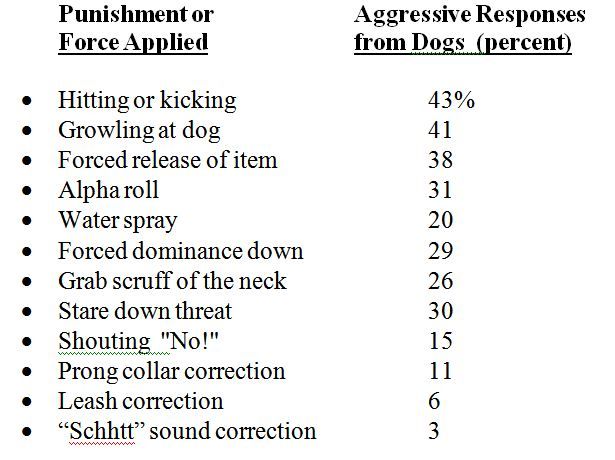Punishment
Is Punishment an Effective Way to Change the Behavior of Dogs?
Use of punishment during dog training leads to increased aggression.
Posted May 24, 2012 Reviewed by Jessica Schrader
Probably the hottest continuing controversy among dog experts has to do with the use of punishment in dog training. Although positive dog training techniques have become widespread, "discipline"-based training using physical force has become more common because of certain popular television shows that feature it, and a number of dog training books that advocate it.
Common punishing or confrontational techniques used to control dogs include sharp leash corrections meant to cause discomfort; hitting or kicking the dog; applying electric shock; applying physical force to pressure a dog into a submissive down position; or the “alpha roll,” which forces the dog on its back in an apparently submissive position, plus a variety of other techniques involving shouting, threatening stares or growls, use of water sprays or water guns, grabbing the dog by the scruff of the neck or the jowls and shaking it, and similar procedures.
The use of such punishing and confrontational methods seems to have grown from the presumption that canine misbehavior or aggression is rooted in the dog’s attempt to express social dominance over its owner, and this has been triggered by a lack of assertiveness or authority on the part of that owner. Advocates of such theories suggest that dog owners need to establish themselves as the ‘‘alpha’’ or ‘‘pack leader," using physical manipulations, threat, and intimidation in order to do so. The application of force is supposed to compel the dog into adopting a less challenging, more compliant, subordinate attitude. These ideas persist even though research has suggested that such beliefs based upon data collected on the behavior of wolves in packs are likely wrong (click here for an example).
I began to think about this issue once again when a new study appeared in the journal Pediatrics. This study dealt with human children, not dogs, and looked at the effects of spanking. Spanking is the most common form of punishment used to control the behavior of human children. Based on data from nearly 2,500 children, Catherine Taylor and her associates at Tulane University report that children that were spanked more frequently at age 3 were much more likely to be aggressive by age 5. "The odds of a child being more aggressive at age 5 increased by 50 percent if he had been spanked more than twice in the month before the study began," said Taylor. Such negative effects of punishment have been reported so often in the scientific literature that the American Academy of Pediatrics has chosen not to endorse spanking under any circumstance. According to the Academy, it's a form of punishment that becomes less effective with repeated use and also makes discipline more difficult as the child outgrows it.
You might ask what relevance a study on human children has to do with our understanding of dog behavior. There is a lot of evidence that suggests that the mind of a dog is roughly equivalent to the mind of a human 2- to 3-year-old child (click here for an example). That alone would suggest that we might learn more about dogs by studying the psychology of young humans, much the same way that psychologists extrapolate findings from animal research to predict the behavior of people. However, in this case we are also assisted by the fact that there is a relevant piece of research that reaches much the same conclusion about the effects of punishment on dogs.
Meghan Herron and her colleagues from the School of Veterinary Medicine at the University of Pennsylvania reported in the journal Applied Animal Behavior Science that using punishing techniques when training dogs tends to increase the aggression in the animals, in much the same way that spanking increases aggressive responses in human children. Just how aggressively dogs responded to these negative control methods, depended upon the severity and nature of the technique used to force or punish the dog. Thus 43 percent of the dogs increased their aggression in response to being hit or kicked, while only 3 percent showed an increase in aggression associated in response to a corrective sound such as “schhtt!” or “uh-uh!” A listing of some of their findings is below.

One thing in this study that I found surprising had to do with leash corrections. These are not usually recommended by positive dog trainers because they might produce fearfulness and aggression in the dog. However, in this study, only 6 percent of the dogs responded aggressively to leash corrections, and 63 percent of the owners who used such corrections felt that they had a positive effect. However the study had no way to monitor the severity of leash corrections, so it may well be that using the leash more in the manner of guidance rather than punishment is what we are encountering here.
What does come out of this study is a confirmation that the use of punishing techniques on dogs has much the same effect that the use of physical punishment has on human children—namely an increase in aggressive behavior in general, and specifically increased aggression toward the individual who is applying the punishment. Given these findings, recommendations advocating the use of punishing and confrontational methods as part of dog training and behavior control seem to be ill-advised.
Stanley Coren is the author of many books, including Born to Bark, The Modern Dog, Why Do Dogs Have Wet Noses? The Pawprints of History, How Dogs Think, How To Speak Dog, and more.
Copyright SC Psychological Enterprises Ltd. May not be reprinted or reposted without permission.


